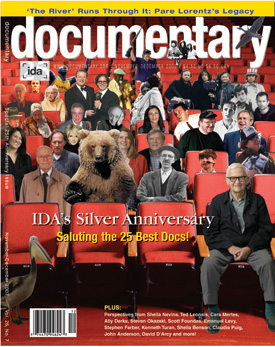
(First appeared in Documentary magazine, November-December 2007)
A revolution in distribution is well underway. The old rules no longer apply, but most distributors continue to do business as if little has changed. Many filmmakers don’t yet fully understand the unprecedented opportunities newly available to them.
Before the revolution, it was the Age of Dependent Distribution. The studios and other distributors were in full control. As gatekeepers and middlemen, they controlled access to audiences in a top-down distribution system. Filmmakers approached them as supplicants, offering them exclusive control of their films in one sector (such as television or home video) or all sectors. There were a few exceptions, such as filmmakers who self-distributed their films theatrically, and New Day Films, the filmmaker co-op focused on educational distribution.
The vast majority of filmmakers became totally dependent during distribution. Many sought overall deals, giving one company all of their distribution rights in North America for 15 to 25 years. Although many filmmakers who made overall deals ended up unhappy, this didn’t deter others from pursuing such deals.
Things changed very little following the digital revolution in production. The availability of affordable digital cameras and software enabled filmmakers to own the means of production for the first time. They could now be truly independent while making their films. But when it came to distribution, old ways and attitudes continued. However proactive and tenacious filmmakers were when willing their films into existence, most became reactive and cautious when bringing them into the world, simply choosing among the conventional distribution offers they received.
A new Age of Independent Distribution is dawning, allowing filmmakers to maintain greater control of their distribution than ever before. Creative distribution strategies are enabling them to get their films out more widely, earn more money and have greater political impact than would be possible through traditional distribution deals. Some filmmakers have netted over $1million selling a single film from their website.
This new Age of Independent Distribution provides unprecedented opportunities. It gives filmmakers:
Direct Access to Viewers
Filmmakers can sell DVDs and digital downloads directly to consumers from their websites, build a mailing list of buyers and subscribers, communicate with them regularly and benefit from their referrals and suggestions.
Global Distribution
Filmmakers can make their films available to anyone with Internet access anywhere in the world. They can supplement deals made by their foreign sales agents by allowing consumers in unsold territories to order directly from their websites.
Access to Target Audiences
Filmmakers can identify, reach and sell to niche audiences via online and offline partnerships in ways never before possible. They can partner with websites and organizations to exchange links, engage in affiliate marketing and organize house parties across the country.
Direct Revenue Flow
Filmmakers can make much greater profit margins on DVDs sold directly from their websites (as compared with DVDs sold in retail). They can also sell from their websites other versions of a film and related products (books, CDs, T-shirts), as well as past work.
Hybrid Distribution
Filmmakers can maximize sales and limit cross-collateralization by retaining the right to sell directly from their websites and splitting other rights among capable distribution partners.
A Core Personal Audience
Filmmakers can build and nurture a base of supporters for past, current and future work. They can build relationships with customers, converting them from consumers to supporters and mentors.
Greater Control of Distribution
Filmmakers have more control over their distribution than ever before. They now have a full spectrum of possibilities, ranging from making a single overall deal to retaining full control of their rights and handling everything themselves. In most cases, the optimum approach will be somewhere in the middle of the spectrum—making deals with effective distribution partners while retaining the right to sell directly from their own websites.
Given these fundamental changes, how can filmmakers maximize their distribution? There are seven things every filmmaker should do:
1) Research digital distribution opportunities and keep abreast of new developments. Learn the lessons from recent case studies and the experience of colleagues.
2) Design a distribution strategy customized to the content of your film and its primary target audiences. A well-designed strategy may help secure the resources to make the film and partially finance its marketing and distribution.
3) Create a website as soon as possible. Like the distribution strategy, the website should be regularly refined and updated. It can be used to build awareness, launch a mailing list and attract supporters and donations.
4) Seek partners who can help with distribution, including national nonprofits, websites, mailing lists, foundations that can fund outreach and corporations that can provide underwriting.
5) Build a distribution team, which can include a web designer/master, an outreach coordinator, publicists (film and online), a distribution consultant, a producer’s rep, a foreign sales agent, a theatrical booker and interns.
6) Be strategic with distributors: Research and identify appropriate distributors, and plan how best to approach them and when to show them your film. If you receive offers, do your due diligence by speaking with other filmmakers who are in business with these distributors.
7) Make your distribution happen. Avoid the old mindset of “hoping to get distribution,” which allows others to determine your fate. Today, no one can stop you from making a film, bringing it into the world and reaching your target audiences.